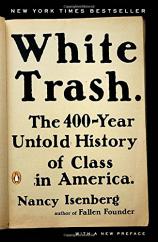White Trash: The 400-Year Untold History of Class in America
Review
White Trash: The 400-Year Untold History of Class in America
Equality in America is a work in progress. In this bold historical exploration, Nancy Isenberg seeks to show that from the earliest days up to the present, there have always been distinct underclasses in the land of opportunity.
Leaving aside the Pilgrims and other groups that arrived in the New World already organized and prepared, Isenberg looks instead at those oppressed groups who were sent here against their will, those who came to labor and not to own. Ben Franklin was proof that anyone could make something of himself, and those who did not quickly became alienated from the ambitious majority. An early negative nickname for the “waste” class was “squatter.” These underlings were seen by their more prosperous neighbors as lazy, stupid, immoral and disease-prone.
"In this bold historical exploration, Nancy Isenberg seeks to show that from the earliest days up to the present, there have always been distinct underclasses in the land of opportunity."
Even a well-known legend like U.S. Congressman Davy Crockett was too rough-hewn for many people’s tastes; he traded on his backwoods image, boasting that he could “whip his weight in wildcats,” while assiduously advocating for the rights of his poor constituents. Andrew Jackson was likewise considered “of the wrong stock,” a Washington outsider prone to violence. Abe Lincoln was suspect for his humble Kentucky origins, pitted against the aristocratic West Pointer Jefferson Davis. The Civil War brought further layering to the class divide, with both sides trying to win the loyalty of lower class Southern whites by convincing them that by joining in the fight they could improve their lowly lot.
By the 20th century, the mythology of white trash was firmly set in American consciousness, in many iterations, from the Hatfields and McCoys of Appalachia to John Steinbeck’s Tom Joad, to Sheriff Andy Taylor and the denizens of Mayberry, to the cheaply flashy women glibly labeled “trailer trash.” Bill Clinton was able to parlay his humble roots into a “Bubba” image --- “turning crackers and rednecks into something Americans could embrace.” Dolly Parton, Elvis, even Sarah Palin all played a role in the development of cracker chic.
On the less savory side, eugenicists used pseudo-science to try to rid the country of inferior stock; Jim and Tammy Sue Bakker shamelessly traded on the battered hopes of the underclasses, promising them heavenly abundance in exchange for earthly donations; and films like Deliverance kept alive the unsavory image of inferior, isolated white mongrels, giving the elites and wannabes plenty of incentive to guard their privilege.
Nancy Isenberg undertakes a hefty task in identifying America’s class divide. Some readers will feel uncomfortable with her assertion that “if the American dream were real, upward mobility would be far more in evidence.” But to ignore the truth of that statement is to deepen the divide that we cannot wish away.
Reviewed by Barbara Bamberger Scott on September 9, 2016
White Trash: The 400-Year Untold History of Class in America
- Publication Date: April 4, 2017
- Genres: History, Nonfiction
- Paperback: 496 pages
- Publisher: Penguin Books
- ISBN-10: 0143129678
- ISBN-13: 9780143129677





